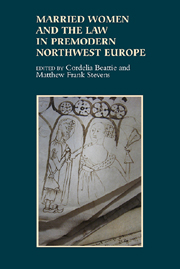Book contents
- Frontmatter
- Contents
- Figures and Tables
- Contributors
- Introduction: Uncovering Married Women
- 1 Inheritance, Property and Marriage in Medieval Norway
- 2 Spousal Disputes, the Marital Property System, and the Law in Later Medieval Sweden
- 3 When Two Worlds Collide: Marriage and the Law in Medieval Ireland
- 4 Married Women, Crime and the Courts in Late Medieval Wales
- 5 Peasant Women, Agency and Status in Mid-Thirteenth- to Late Fourteenth-Century England: Some Reconsiderations
- 6 London's Married Women, Debt Litigation and Coverture in the Court of Common Pleas
- 7 Married Women, Contracts and Coverture in Late Medieval England
- 8 Property, Family and Partnership: Married Women and Legal Capability in Late Medieval Ghent
- 9 ‘For His Interest’? Women, Debt and Coverture in Early Modern Scotland
- 10 The Worth of Married Women in the English Church Courts, c.1550–1730
- 11 Married Women, Work and the Law: Evidence from Early Modern Germany
- Index
1 - Inheritance, Property and Marriage in Medieval Norway
Published online by Cambridge University Press: 05 July 2013
- Frontmatter
- Contents
- Figures and Tables
- Contributors
- Introduction: Uncovering Married Women
- 1 Inheritance, Property and Marriage in Medieval Norway
- 2 Spousal Disputes, the Marital Property System, and the Law in Later Medieval Sweden
- 3 When Two Worlds Collide: Marriage and the Law in Medieval Ireland
- 4 Married Women, Crime and the Courts in Late Medieval Wales
- 5 Peasant Women, Agency and Status in Mid-Thirteenth- to Late Fourteenth-Century England: Some Reconsiderations
- 6 London's Married Women, Debt Litigation and Coverture in the Court of Common Pleas
- 7 Married Women, Contracts and Coverture in Late Medieval England
- 8 Property, Family and Partnership: Married Women and Legal Capability in Late Medieval Ghent
- 9 ‘For His Interest’? Women, Debt and Coverture in Early Modern Scotland
- 10 The Worth of Married Women in the English Church Courts, c.1550–1730
- 11 Married Women, Work and the Law: Evidence from Early Modern Germany
- Index
Summary
This essay will highlight the position, capabilities and options of married women, according to Norwegian medieval law, regarding their control of property. Women's control and disposal of property during marriage were conditioned and influenced by a long series of factors - pertaining not only to legal regulations of different kinds but also to a broad field of interests, involving several actors and relations, such as the relationship between spouses themselves, the relationship to direct, lineal descendants, and the relationship between the conjugal couple and their kin groups on both sides. In order to evaluate the capabilities of married women in controlling property, and the possible strategies they employed, this wider ‘space of action’ must be taken into consideration.
The position of married women in controlling property will be discussed on the basis of the legal situation drawn up by the first nation-wide law codex encompassing the whole medieval Norwegian monarchy, which was established by king Magnus the lawmender in 1274. In contrast to the former provincial laws, this National Law Code introduced new principles for women's access to inheritance, thus influencing greatly women's options for acquiring control over property. However, as many of the regulations in this law related to principles that had been introduced into the provincial laws during the two preceding centuries, a short overview of previous developments is needed. This concerns above all the principles and conditions for contracting a valid marriage, the introduction and successive curtailment of marriage prohibitions according to canon law, and the rules regulating property transactions and exchange of gifts by contracting marriage.
- Type
- Chapter
- Information
- Married Women and the Law in Premodern Northwest Europe , pp. 11 - 30Publisher: Boydell & BrewerPrint publication year: 2013



